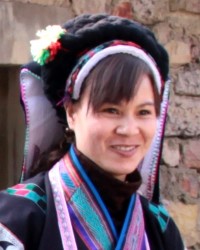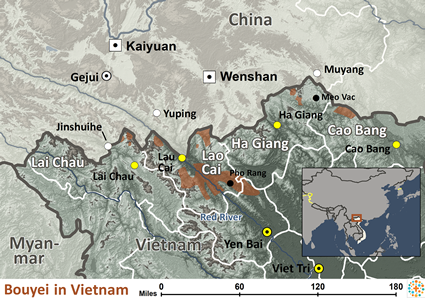The Bouyei immigrated into what is now northern Vietnam from China about 200 years ago. They have close cultural relations with the Nung and other Thai groups. Unfortunately, the rapid population growth in Vietnam has strained the limited social services and food supplies. To relieve these problems, the government set up what they call a "family planning program." They resettled several million people into new economic areas.
The Bouyei are primarily farmers and cattle producers. Generally, they live in houses built on stilts. Most also have a second home located on farm clearings where older people mind the crops, cattle, and poultry. Handicrafts are poorly developed, aside from the weaving of bamboo household items.
Traditionally, Bouyei women wear typical Vietnamese style clothing, which includes carrying embroidered cloth bags. Their hair is rolled around their heads, then tied with pink threads that are usually left dangling down their backs.
Each year the Bouyei celebrate their anticipated harvest in a festival called roong pooc. Every family owns land to plant rice, maize, sweet potatoes, cassava, gourds and vegetables. They use buffaloes for plowing, horses as beasts of burden, and poultry for meat and sacrificial offerings.
Communal, or shared land, is prominent in Bouyei society. Each village has a piece of forbidden forest called ma doong xia ("sacred forest"). They hold a ceremony twice a year at the biggest tree, called "the forest chief," honoring the village spirits. Bamboo structures at the village entrance hold offerings of pig, buffalo ears or chicken legs.
Bouyei society is patrilineal (inheritances are passed down through the males) and patriarchal (male-dominated). Families tend to be small. According to Bouyei tradition, a woman has three people to whom she must submit: her father before marriage, her husband, then her son after her husband's death. Young people are free to choose their own marriage partners.
They profess Hinduism, and Chammunda and Ambajee are their family deities. Their regional deities are Hanuman, Shankar, Mahakali and Ramdevjee.PRGRPHTo follow Jesus is to breach community norms, bringing significant ostracism and disfavor.
The Sargara community needs the support of the Indian judiciary. Most live in rural areas where young women are pledged to be married at a very young age. This keeps women from getting the education they need.
Ask the Lord to call people who are willing to share Christ with the Bouyei.
Ask God to give the few Bouyei believers opportunities to share the gospel with their own people.
Pray that God will open the hearts of Vietnam's governmental leaders to the gospel, leading to many Christ followers within the Hanoi government.
Ask God to raise up teams of intercessors who will stand in the gap for these precious people.
Ask the Lord to raise up a strong local church among the Bouyei of Vietnam.
Pray for a spiritual hunger that will give the Bouyei people a willingness to accept the eternal blessings of Jesus Christ.
Scripture Prayers for the Bouyei in Vietnam.
https://en.wikipedia.org/wiki/Bouyei_people
Peoples of Vietnam, Asia Harvest, Copyrighted © Used with permission.
| Profile Source: Joshua Project |


























